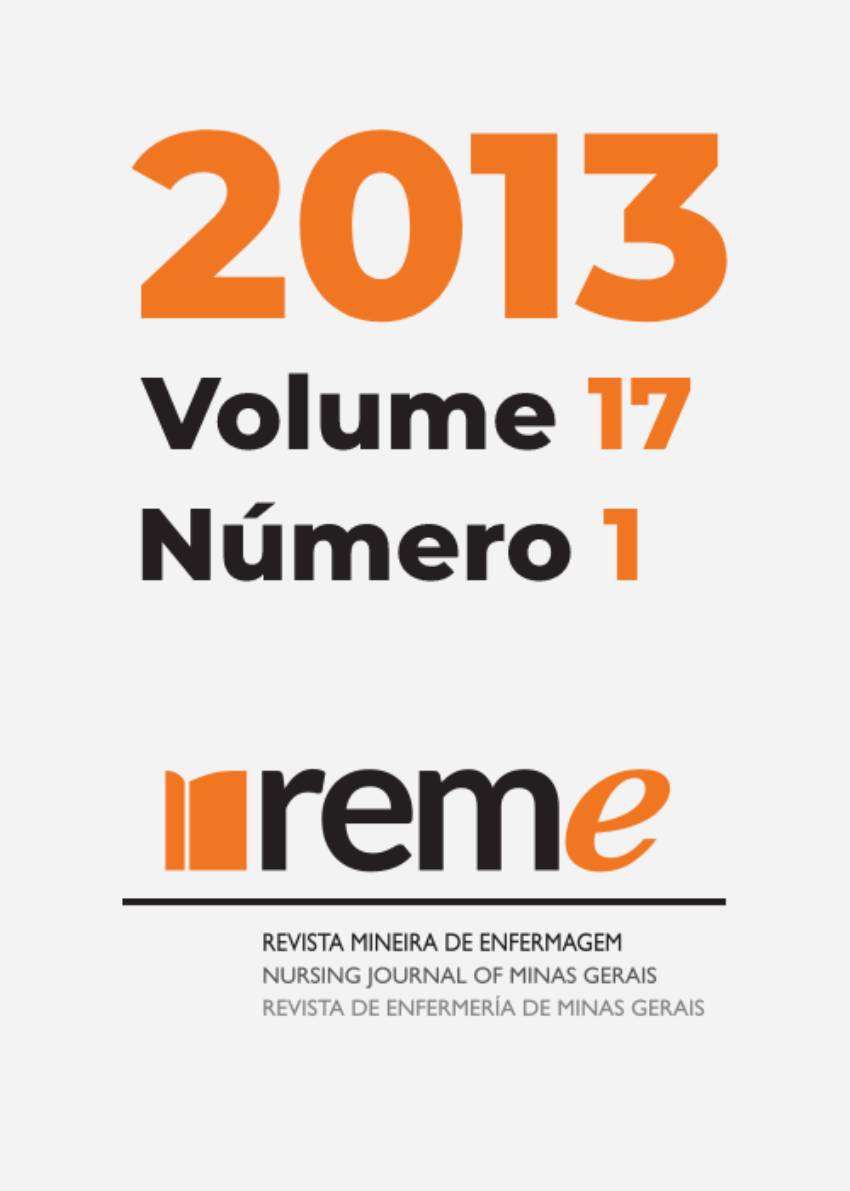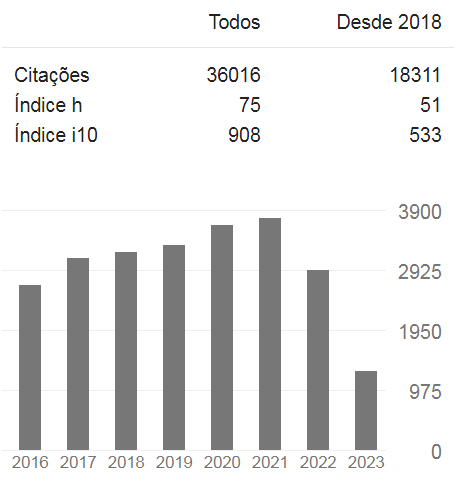Evaluation of the implementation of new protocol of oral hygiene in an intensive care center for prevention of pneumonia associated with mechanical ventilation
DOI:
https://doi.org/10.35699/2316-9389.2013.50252Keywords:
Pneumonia, Ventilator-Associated, Oral Hygiene, ChlorhexidineAbstract
Ventilator-associated pneumonia (VAP) is one of the most prevalent infections in hospital intensive care unit (ICU). Among the risk factors highlight the microaspiration of oropharyngeal microorganisms. The strategy for prevention of VAP bundle was the creation of ventilation. However, not all strategies are included in the bundle, for example, the oral hygiene. This study aimed to assess the oral hygiene procedures to prevent VAP. We conducted a review of secondary data from the infection control committee of the hospital between 2008 to 2011 presented by frequency of occurrence. We also evaluated the perception of health professionals in the ICU on the implementation of the protocol of oral hygiene. After signing the informed consent a questionnaire was administered. Pneumonia was the primary cause of infection in the ICU from 2008 to 2010. In 2011 after deploying the bundle fails to lead to pneumonia as the most frequent. Percentage reduction in numbers of pneumonia after the deployment bundle to the incorporation of oral hygiene protocol ranged from 33.3% to 3.5%. About the perception of professionals about the insertion of dental professionals in the ICU 56 respondents, citing oral hygiene as the second most important measure. 100% of professionals said to be favorable to the dentist's inclusion in the ICU. The vast literature demonstrates the efficiency of the protocol of oral hygiene in the prevention of VAP, so it is recommended the inclusion of this measure in the bundle.Downloads
References
Morais TMN, Silva A, Knobel E, Avi ALRO, Lia RCC. Pacientes em unidades de
terapia intensiva: atuação conjunta dos médicos e dos cirurgiões-dentistas.
In: Serrano JR CV, Oliveira MCM, Lotufo RFM, Moraes RGB, Morais TMN,
coordenadores. Cardiologia e odontologia: uma visão integrada. São Paulo:
Livraria Santos; 2007. cap.15, p.249-70.
Beraldo CC, Andrade D. Higiene bucal com clorexidina na prevenção de
pneumonia associada à ventilação mecânica. J Bras Pneumol. 2008; 34(9):707-14.
Chlebicki MP, Safdar N. Topical chlorhexidine for prevention of ventilatorassociated pneumonia: a meta-analysis. Crit Care Med. 2007; 35(2):595-602.
Muscerere J, Dodek P, Keenan S, Fowler R, Cook D, Heyland D, et al.
Comprehensive evidence-based clinical practice guidelines for ventilatorassociated pneumonia: prevention. J Crit Care. 2008; 23: 126-37.
Chan EY, Ruest A, Meade MO, Cook DJ. Oral decontamination for prevention
of pneumonia in mechanically ventilated adults: systematic review and
meta-analysis. Br Med J. 2007; 334(7599):889.
Ruffell A, Adamcova L. Ventilator-associated pneumonia: prevention is
better than cure. Nurs Crit Care. 2008 Jan-Feb;13(1):44-53.
Tantipong H, ChantanaM, Jaiyindee S, Thamlikitkul V. Randomized Controlled
Trial and Meta-analysis of Oral Decontamination With 2% Chlohexidine
Solution for the Prevention of Ventilator-Associated Pneumonia. Infect
Control Hosp Epidemiol. 2008; 29:131-6.
Garcia R, Jendresky L, Colbert L. Reduction of Microbial Colonization in the
Oropharynx and Dental Plaque Reduces Ventilator-Associated Pneumonia.
APIC Conference, Jun 2004.
Panchabhai TS, Dangavach NS, Krishnan A, Kothari VM, Karnad DR.
Oropharyngeal cleansing with 0.2% Chlorhexidine for prevention of
Nosocomial pneumonia in critically ill Patients. Chest. 2009; 135:1150-6.
Munro CL, Grap MJ, Jones DJ, Mcclish DK, Sesser CN. Chlorhexidine,
Toothbrushing, and Preventing Ventilator-Associated Pneumonia in
Critically Ill Adults. Am J Crit Care. 2009;18: 428-37.
Fernandes AT, Zamorano PO, Torezan Filho MA. Pneumonia hospitalar. In:
Fernandes AT, Fernandes MOV, Ribeiro Filho N. Infecção hospitalar e suas
interfaces na área de saúde. São Paulo: Atheneu; 2000. cap.21, p.516-54.
Amaral SM, Cortês AQ, Pires FR. Pneumonia nosocomial: importância do
microambiente oral. J Bras Pneumol. 2009; 35(11):1116-24.
Pereira CA, Carvalho CRR, Silva JLP, Dalcolmo MMP, Messeder OHC. Consenso
Brasileiro de Pneumonias em Indivíduos Adultos Imunocompetentes. J
Pneumol. 2001; 27: 22-41.
CDC. The National Healthcare Safety Network (NHSN) Manual. Healthcare
personnel safety component protocol, 2009. [Citado em 2011 set 10].
Disponível em: http://www.cdc.gov/nhsn/PDFs/HSPmanual/HPS_Manual.pdf.
Pinheiro PG, Salani R, Aguiar ASW, Pereira SL. Perfil periodontal de indivíduos
adultos traqueostomizados com pneumonia nosocomial. Rev Periodont.
;17(3):67-72.
Oliveira LCBS, Carneiro PPM, Fisher RG, Tinoco EMB. A presença de
patógenos respiratórios no biofilme bucal de pacientes com pneumonia
nosocomial. Rev Bras Ter Intens. 2007; 19(4): 428-43.
Pace MA, Watanabe E; Facetto MP, Andrade D. Staphylococcus spp. na saliva
de pacientes com intubação orotraqueal. Rev Panam Infectol. 2008;10(2):8-12.
Morais TMN, Silva A, Avi ALRO, Souza PHR, Knobel E, Camargos LFA. A
importância da atuação odontológica em pacientes internados em unidade
de terapia intensiva. Rev Bras Ter Intens. 2006;18(4):412-7.
Bergmans DC, Bonten MJ, Gaillard CA, Paling JC, Geest SVD, Tiel FHV et al.
Prevention of ventilator-associated pneumonia by oral decontamination:
a prospective, randomized, double-blind, placebo-controlled study. Am J
Respir Crit Care Med. 2001; 164(3):382-8.
Santos PSS, Mello WR, Wakim RCS, Paschoal MAG. Uso de solução bucal
com sistema enzimático em pacientes totalmente dependentes de cuidados
em unidade de terapia intensiva. Rev Bras Ter Intens. 2008; 20(2):154-9.
Araújo RJG, Oliveira LCG de, Hanna LMO, Correa AM, Carvalho LHV, Álvares
NCF. Análise de percepções e ações de cuidados bucais realizados por
equipes de enfermagem em unidades de tratamento intensivo. Rev Bras Ter
Intens. 2009; 21(1):38-44.
Reche NSG. Controle da placa dental em deficientes mentais com o uso da
clorexidina. 2005. 72 p. Dissertação (Mestrado em Clínica Odontológica).
Marília-SP: Universidade de Marília; 2005.
Zanatta FB, Rösing CK. Clorexidina: mecanismo de ação e evidências atuais
de sua eficácia no contexto do biofilme supragengival. Scientific-A 2007;
(2):35-43.
Tortora GJ, Funke BR, Case CL. Controle do crescimento microbiano. In:
Tortora GJ, Funke BR, Case CL. Microbiologia. 6ª ed. Porto Alegre: Artmed;
p.181-206.
Gebran MP, Gebert APO. Controle químico e mecânico de placa bacteriana.
Tuiuti: ciência e cultura, Curitiba 2002; (26):45-58.
Fávero MLD, Pontarolo R, Sato MEO, Andreazza IF, Machado A.
Desenvolvimento de dentifrício como veículo para o uso de digluconato
de clorexidina no controle químico da placa bacteriana, 2004 [dissertação].
Programa de pós- graduação em ciências farmacêuticas – Universidade
Federal do Paraná, Curitiba, 2004.
5 Million Lives Campaign. Getting Started Kit: Prevent Ventilator Associated
Pneumonia. Cambridge MA: Institute for Healthcare Improvement; 2008.
[Citado em: 10 ago. 2011]. Disponível em: www.ihi.org.
Munro CL, Grap MJ. Oral health and care in the intensive care unit: state of
the science. Am J Crit Care. 2004; 13(1):25-33.
Grap MJ, Munro CL, Ashtiani B, Bryant S. Oral care interventions in critical
care: frequency and documentation. Am J Crit Care. 2003; 12(2):113-8.
Koeman M, Ven AJAMVD, Hak E, Joore HCA, Kaasjager K, Smet AGA et al.
Oral decontamination with chlorhexidine reduces the incidence of ventilatorassociated pneumonia. Am J Respir Crit Care Med 2006;173(12):1348-55.
Agência Nacional de Vigilância Sanitária. Resolução-RDC nº 7, de 24 de
fevereiro de 2010. [Citado em 2011 set 12]. Disponível em: URL: http://www.
amib.org.br/pdf/RDC-07-2010.pdf.
Hospital Risoleta Tolentino Neves. Histórico. 2011. [Citado em 2011 jun 10].
Disponível em: http://www.hrtn.fundep.ufmg.br/index.php?option=com_
content&task=blogsection &id= 6&Itemid=86.
Souza AF, Neves ALC, Benevenuto MEAC, Costa PM. Uso da clorexidina
,12% na higiene oral de pacientes em unidade de terapia intensiva. 2009. 88f.
Monografia (Graduação em Enfermagem) – Belo Horizonte,Faculdade de
Enfermagem, Universidade José do Rosário Vellano; 2009.
Hospital Risoleta Tolentino Neves. Serviço de Controle de Infecções Hospitalares:
Risco de Infecção associada à assistência e taxas de letalidade no Centro de
Tratamento Intensivo: Jan de 2008 a out de 2011. Belo Horizonte nov 2011.
Moreno R. The customization of APACHE II for patients receiving orthotopic
liver transplants. Critical Care. 2002, 6:188-189.
Ames NJ, Sulima P, Yates JM, McCullagh L, Gollins SL, Soeken K, Wallen
GR.Effects of Systematic Oral Care in Critically Ill Patients: A Multicenter
study. AJCC. 2011; 20(5):
Agência Nacional de Vigilância Sanitária. Infecções do trato respiratório
orientações para prevenção de infecções relacionadas à assistência à saúde.
Brasília: Anvisa; 2009.
Published
How to Cite
Issue
Section
License
Copyright (c) 2013 Reme: Revista Mineira de Enfermagem

This work is licensed under a Creative Commons Attribution 4.0 International License.






































